If you’re living in a small space, it can be a challenge to make it feel comfortable and inviting. But with a few clever interior design tips, you can maximize your space and create a stylish home that you’ll love. Whether you’re living in a tiny apartment or a cozy cottage, there are plenty of ways to make the most of your space.
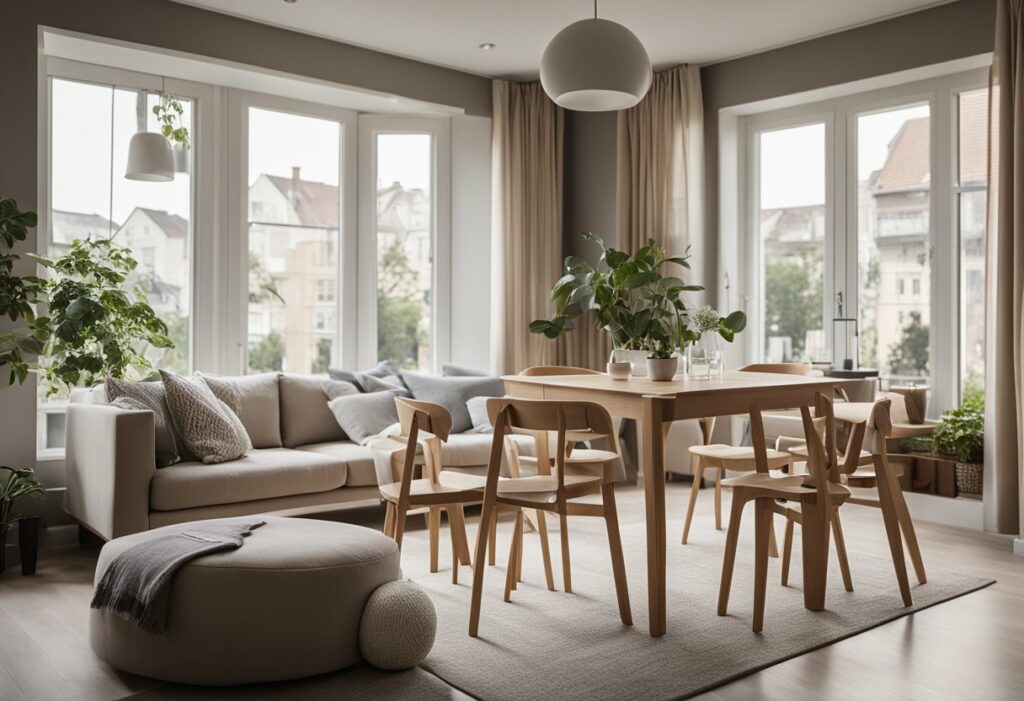
One of the most important things to keep in mind when designing a small space is to focus on maximizing light and colour. By using light colours, mirrors, and other reflective surfaces, you can create the illusion of a larger space and make it feel brighter and more open. You can also use clever lighting solutions, such as pendant lights and floor lamps, to create a warm and inviting atmosphere.
Another key strategy for designing a small space is to carefully consider your furniture and layout. Choosing the right furniture pieces and arranging them in a way that maximizes space can make a big difference in how your home feels. You may also want to consider multi-functional furniture pieces, such as a sofa bed or storage ottoman, to save space and add functionality.
Key Takeaways
- Maximize light and colour to create the illusion of a larger space.
- Carefully consider your furniture and layout to make the most of your space.
- Use storage and decorative techniques to add style and functionality to your small space.
Maximising Light and Colour
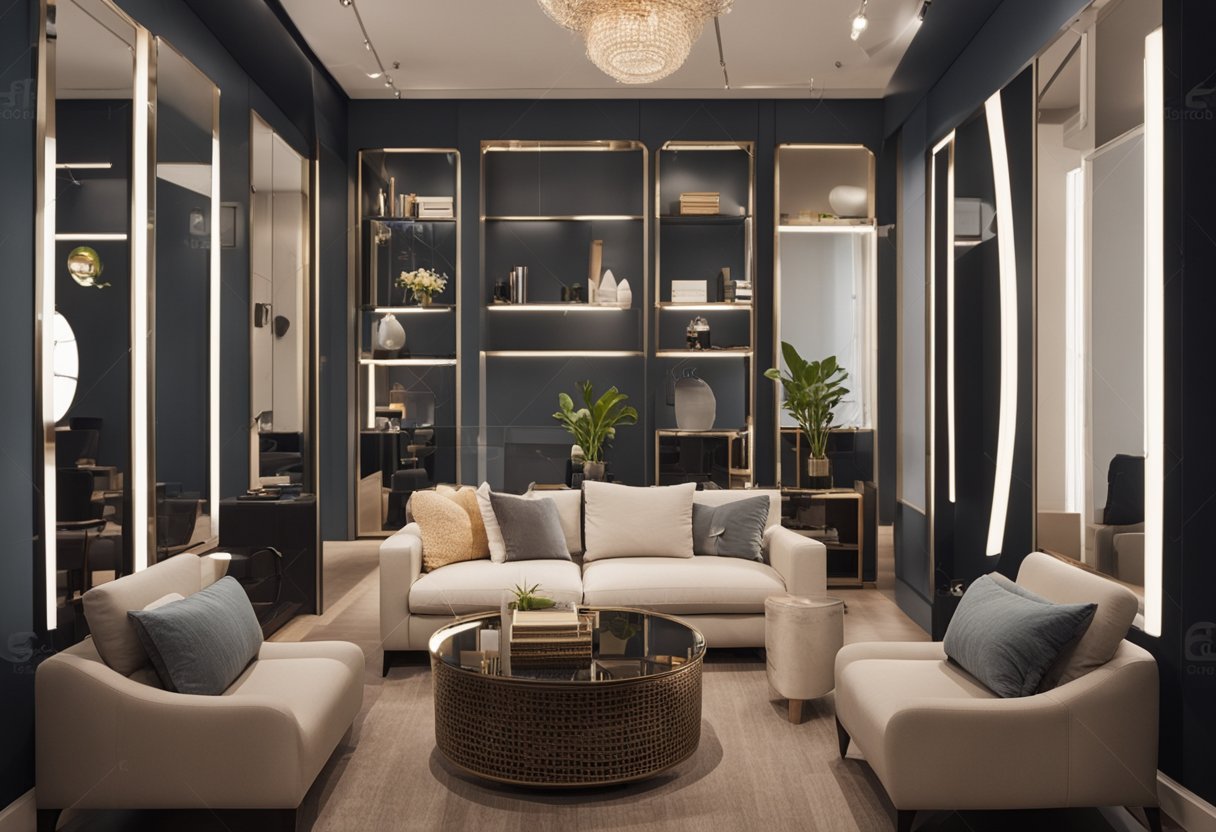
When it comes to designing a small space, the right use of light and colour can make a big difference. Here are some tips to help you maximise the light and colour in your small space.
Choosing the Right Colour Palette
Choosing the right colour palette is crucial when it comes to making a small space feel bigger. Light colours like whites, creams, pastels and soft greys have a visually expanding effect on small spaces. They reflect light and make a small room feel brighter and more open.
It’s important to avoid dark colours as they tend to absorb light and make a small space feel even smaller. However, you can still incorporate darker colours in your small space by using them as accents or in small doses.
Incorporating Effective Lighting Solutions
Effective lighting solutions are essential in small spaces to create the illusion of more space. Here are some lighting solutions that can help you maximise the light in your small space:
- Ceiling lights: Ceiling lights are a great way to light up a small space. They provide ambient lighting and can make a room feel brighter and more open.
- Pendant lights: Pendant lights are a stylish lighting solution that can add character and personality to a small space. They are also great for creating a focal point in a room.
- Sconces: Sconces are wall-mounted light fixtures that can provide both ambient and task lighting. They are ideal for small spaces as they don’t take up any floor space.
- Wall lights: Wall lights are another great way to add ambient lighting to a small space. They can be used to highlight artwork or architectural features in a room.
- Table lamps: Table lamps are a versatile lighting solution that can be used to provide task lighting or ambient lighting. They are also great for adding a decorative touch to a small space.
In conclusion, maximising light and colour is key when it comes to designing a small space. By choosing the right colour palette and incorporating effective lighting solutions, you can create a space that feels brighter, more open and more spacious.
Furniture and Layout Strategies
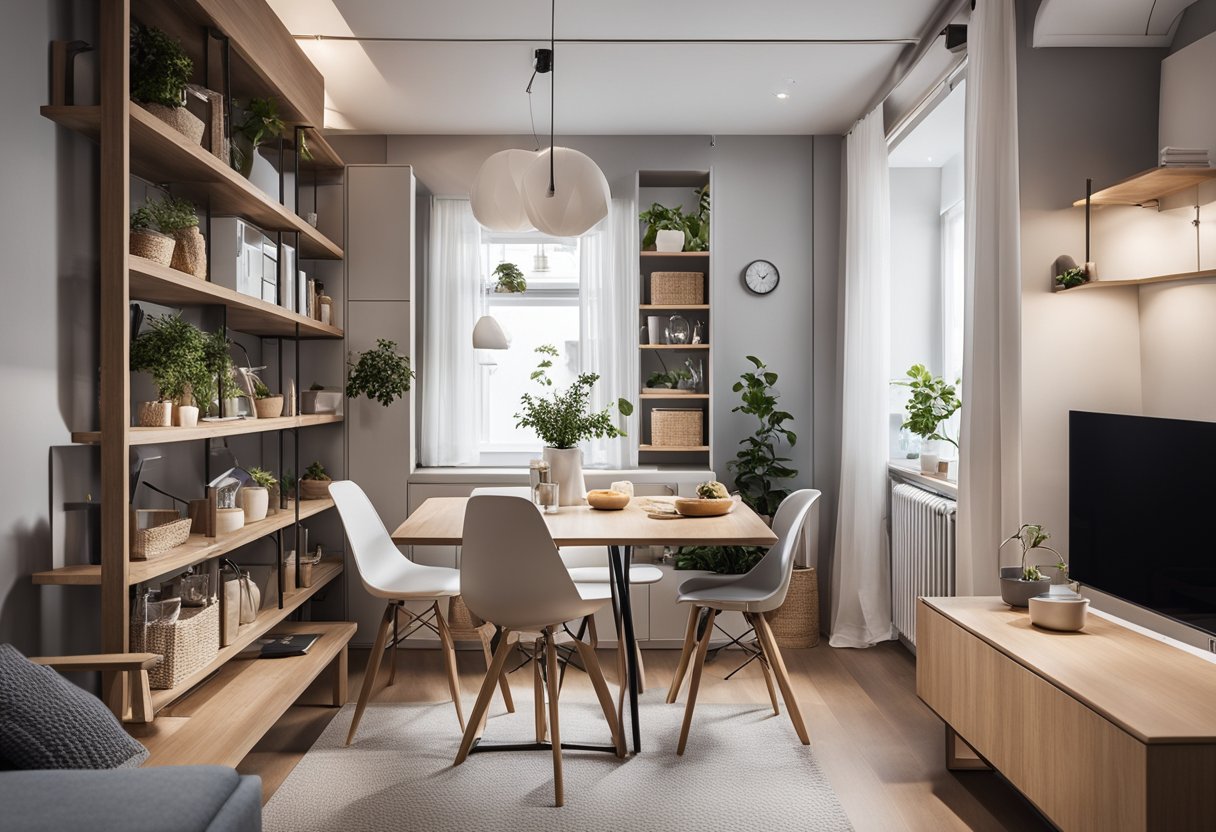
When it comes to decorating small spaces, selecting the right furniture and optimizing the room layout are key. In this section, we’ll explore some space-saving furniture options and layout strategies that will help you make the most of your limited space.
Selecting Space-Saving Furniture
When choosing furniture for a small space, it’s important to prioritize items that are both multi-functional and space-efficient. This means opting for furniture that can serve dual purposes, such as a sofa bed or a dining table that can be folded away when not in use. Additionally, look for furniture pieces that have a smaller footprint, such as armless chairs or a loveseat instead of a full-sized sofa.
Another key consideration when selecting furniture for a small space is storage. Look for pieces that offer smart storage solutions, such as ottomans that double as storage containers or coffee tables with built-in shelving. This will help you keep your space organized and clutter-free.
Optimizing Room Layout
Once you’ve selected your furniture, it’s time to think about how to arrange it in your space. One important layout strategy for small spaces is to create zones within the room. This means dividing the space into different areas for different activities, such as a seating area, a dining area, and a workspace.
To create these zones, consider using area rugs to define the different areas of the room. Additionally, make sure to leave enough space between furniture pieces to allow for easy movement and flow within the room.
Another key layout strategy for small spaces is to take advantage of vertical space. This means using tall bookcases or shelving units to store items and free up floor space. Additionally, consider hanging shelves or wall-mounted storage units to keep items off the floor and out of the way.
By selecting space-saving furniture and optimizing your room layout, you can make the most of your small space and create a functional and stylish living area.
Creating the Illusion of Space
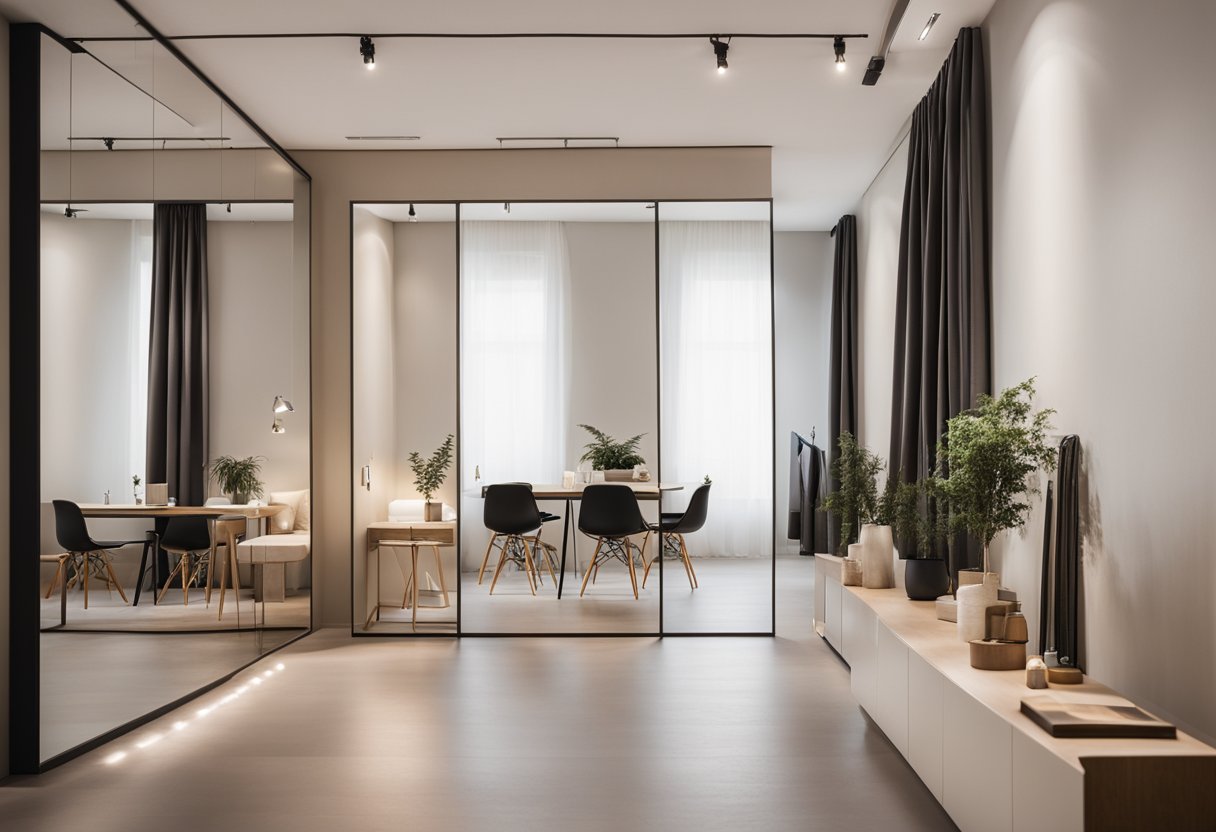
When it comes to small spaces, creating the illusion of space is essential. Luckily, there are a few tricks that interior designers use to make spaces appear bigger, and you can use them too.
Using Mirrors to Add Depth
Mirrors can be a game-changer when it comes to creating the illusion of space. By reflecting light, they can make a room feel brighter and more open. Place a large mirror on the wall opposite a window to reflect the natural light and create the illusion of another window. You can also use mirrors to create the illusion of depth by placing them at angles or in unexpected places.
Strategic Use of Patterns and Detail
The strategic use of patterns and detail can also help to create the illusion of space. Use patterns sparingly and strategically, as too much pattern can overwhelm a small space. Opt for simple patterns such as stripes or polka dots, and use them in moderation. Detail such as a gallery wall or interesting angles can also add dimension to a small space, making it feel more dynamic and less cramped.
Remember, creating the illusion of space is all about using design elements to trick the eye into thinking a space is larger than it actually is. By using mirrors, patterns, and detail strategically, you can create a space that feels open and inviting, no matter how small it may be.
Storage and Decluttering
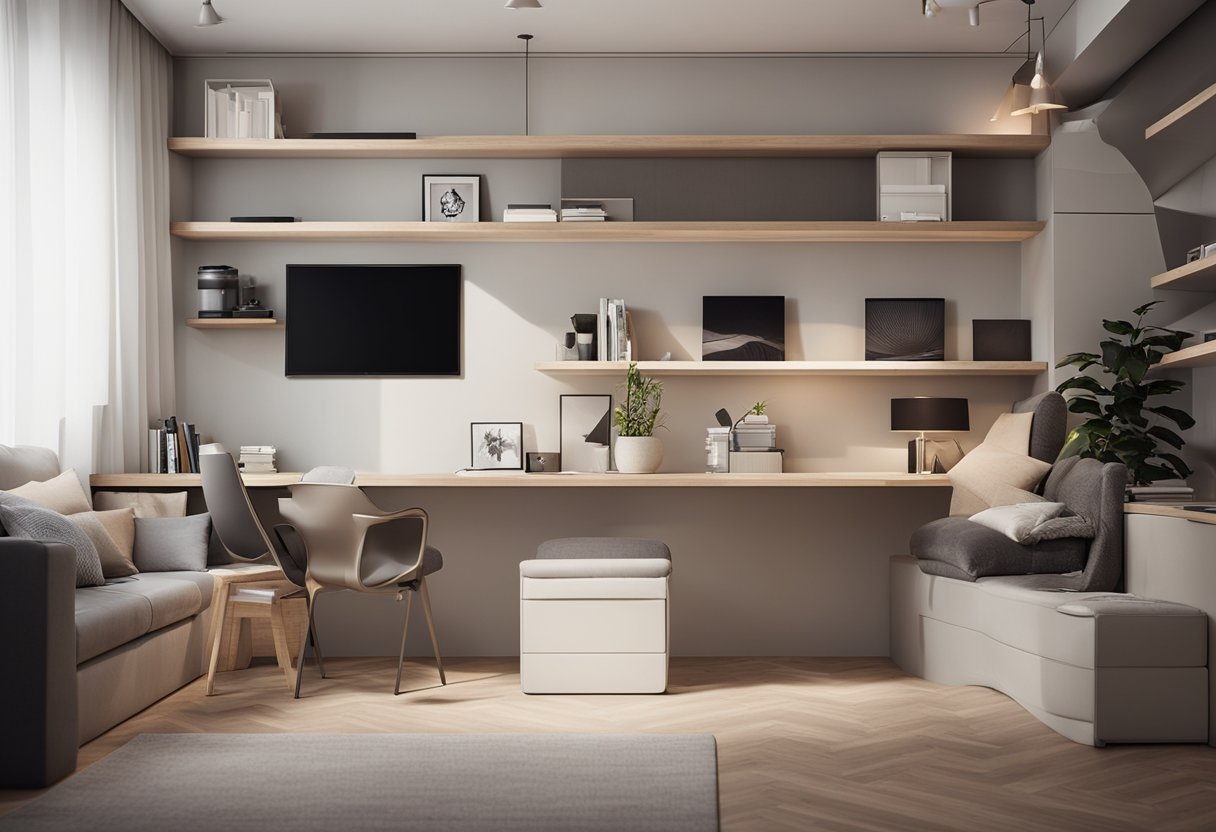
Are you struggling to find a place for all your belongings in your small space? Don’t worry, there are plenty of smart storage solutions that can help you make the most of your limited space.
Smart Storage Solutions
One of the easiest ways to maximize your storage space is to use shelves. Wall-mounted shelves can be a great addition to any small space, providing a place to store books, decorative items, and other small objects. You can also use floating shelves to create an illusion of more space.
Another great way to create more storage space is to invest in multi-purpose furniture. For example, a coffee table with built-in drawers can provide a place to store magazines, remote controls, and other small items. Similarly, an ottoman with a removable lid can be used to store blankets, pillows, and other items.
Storage units are another great option for small spaces. You can find storage units in a variety of sizes and styles, from small cube units to large bookcases. These units can be used to store everything from books and DVDs to clothing and shoes.
The Art of Decluttering
Clutter can make any space feel smaller, so it’s important to keep your small space clutter-free. Here are a few tips to help you declutter:
- Pare back your stuff. Regularly decluttering is important in any home, but even more so if you’re short on storage space. With fewer items to store, you can avoid overcrowding and utilize the space available to its best potential.
- Throw out anything you no longer use. If you haven’t used an item in the past year, it’s probably time to get rid of it.
- Get rid of items you’ve kept “just in case”. If you haven’t needed it in the past year, you probably won’t need it in the future.
- Get rid of furniture you don’t love. If you don’t love it, it’s taking up valuable space that could be used for something else.
By following these tips, you can create a clutter-free, organized space that feels larger than it actually is.
Decorative Techniques
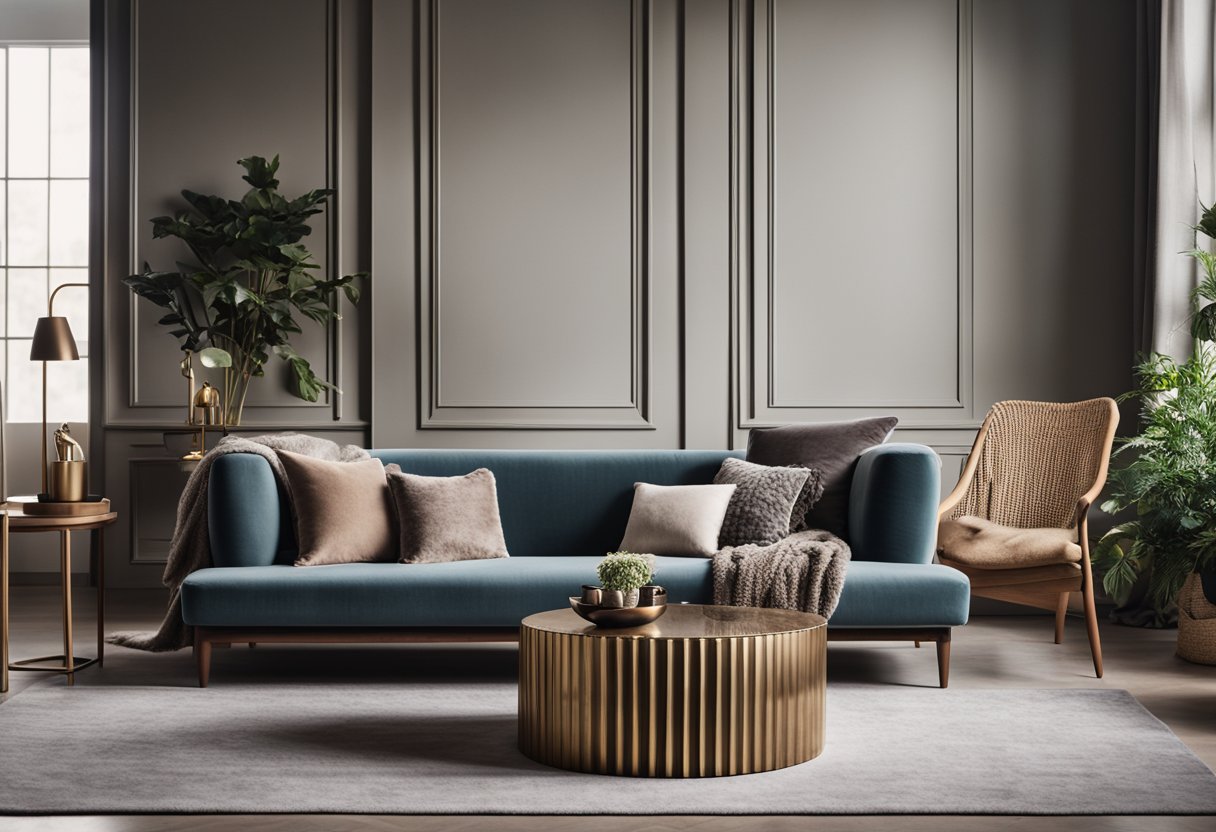
When it comes to decorating small spaces, decorative techniques are your best friend. These techniques can help you create an illusion of a larger space while adding personality and character to your room. Here are two decorative techniques that you can use to make your small space look amazing.
Accentuating with Wallpaper and Paintings
Using wallpaper and paintings is a great way to add depth and texture to your small space. When choosing wallpaper, it’s important to choose a pattern that is not too busy or overwhelming. Go for something subtle and elegant that will add interest to your walls without overpowering the room.
Similarly, when choosing paintings, go for something that is bold and eye-catching. A large painting can create a focal point in the room and draw the eye away from the small size of the space. You can also use a series of smaller paintings to create a gallery wall that will add visual interest to your room.
Adding Layers and Textures
Adding layers and textures is another great way to make a small space look bigger. When it comes to layering, start with a neutral base and then add pops of colour and texture. You can do this by adding throw pillows, blankets, and rugs in bold colours and patterns.
When it comes to textures, don’t be afraid to mix and match. Use a variety of textures, such as velvet, wool, and linen, to create a cozy and inviting space. You can also add trim to your curtains or cushions to add interest and depth to your room.
By using these decorative techniques, you can create a beautiful and inviting space, no matter how small it is. So go ahead and experiment with wallpaper, paintings, layers, and textures to create a space that is uniquely yours.
Special Considerations for Each Room
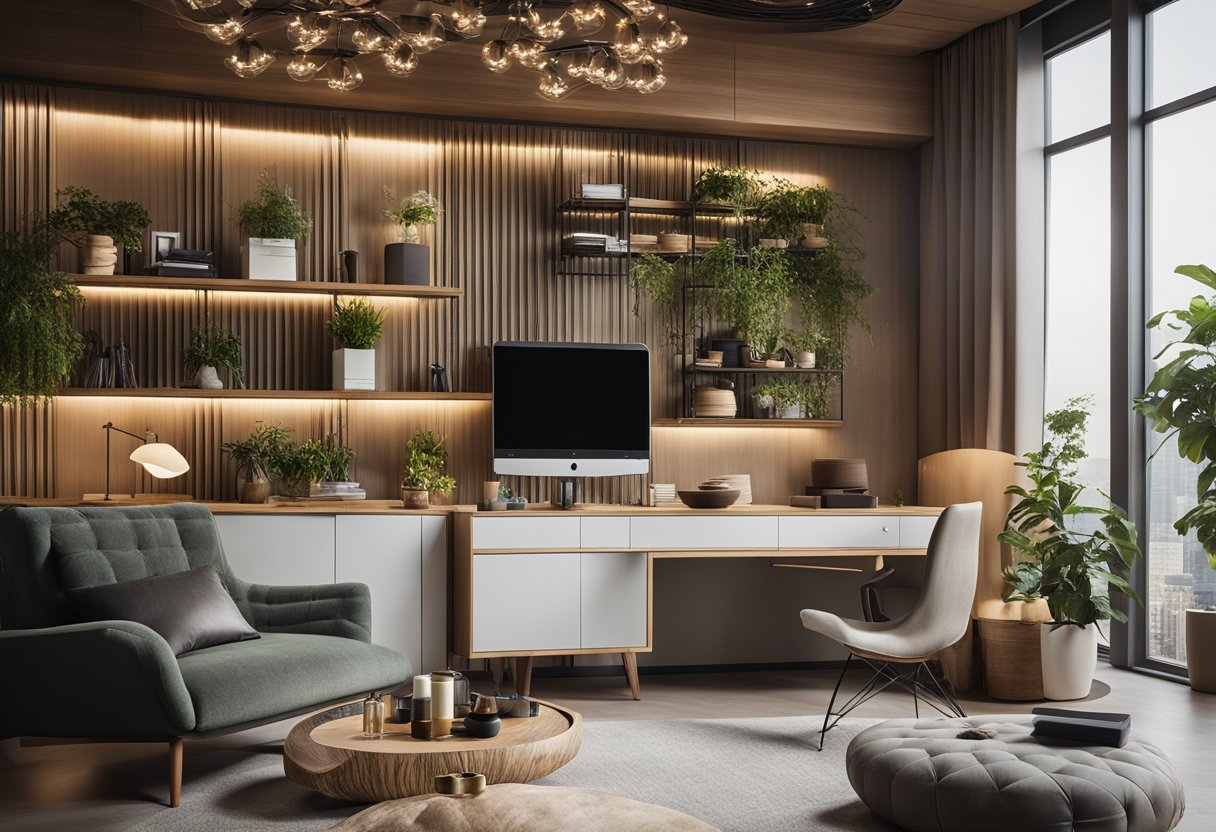
When it comes to designing a small space, it’s important to consider each room individually. Here are some tips for designing a cozy living room and setting up an efficient small office space.
Designing a Cozy Living Room
Your living room is the heart of your home, and it’s important to create a cozy and inviting space. When designing a small living room, it’s important to choose furniture that is proportional to the space. A large sofa may overwhelm the room, so consider a loveseat or a sectional instead.
To create a sense of coziness, consider adding soft textures like plush rugs, throw pillows, and blankets. These elements will make your living room feel warm and inviting. Additionally, consider adding ambient lighting like table lamps and floor lamps to create a relaxing atmosphere.
When it comes to style, consider a minimalist approach. A cluttered living room can feel overwhelming in a small space, so keep your decor simple and streamlined. Choose a neutral color palette and add pops of color with accessories like artwork and decorative objects.
Setting Up an Efficient Small Office Space
If you work from home, setting up an efficient small office space is essential. When choosing a desk, consider a compact option that can fit in a corner or against a wall. A wall-mounted desk is another great option for saving space.
To maximize your storage options, consider adding shelves, cabinets, and storage bins. These elements will keep your workspace organized and clutter-free. Additionally, consider investing in a comfortable desk chair that can be easily tucked away when not in use.
When it comes to style, consider a modern and minimalist approach. A cluttered office can feel overwhelming, so keep your decor simple and streamlined. Choose a neutral color palette and add pops of color with accessories like a desk lamp and artwork.
Overall, designing a small space can be a challenge, but with the right approach, you can create a cozy and efficient home. By considering each room individually and using smart design techniques, you can make the most of your small space.
Professional Insights
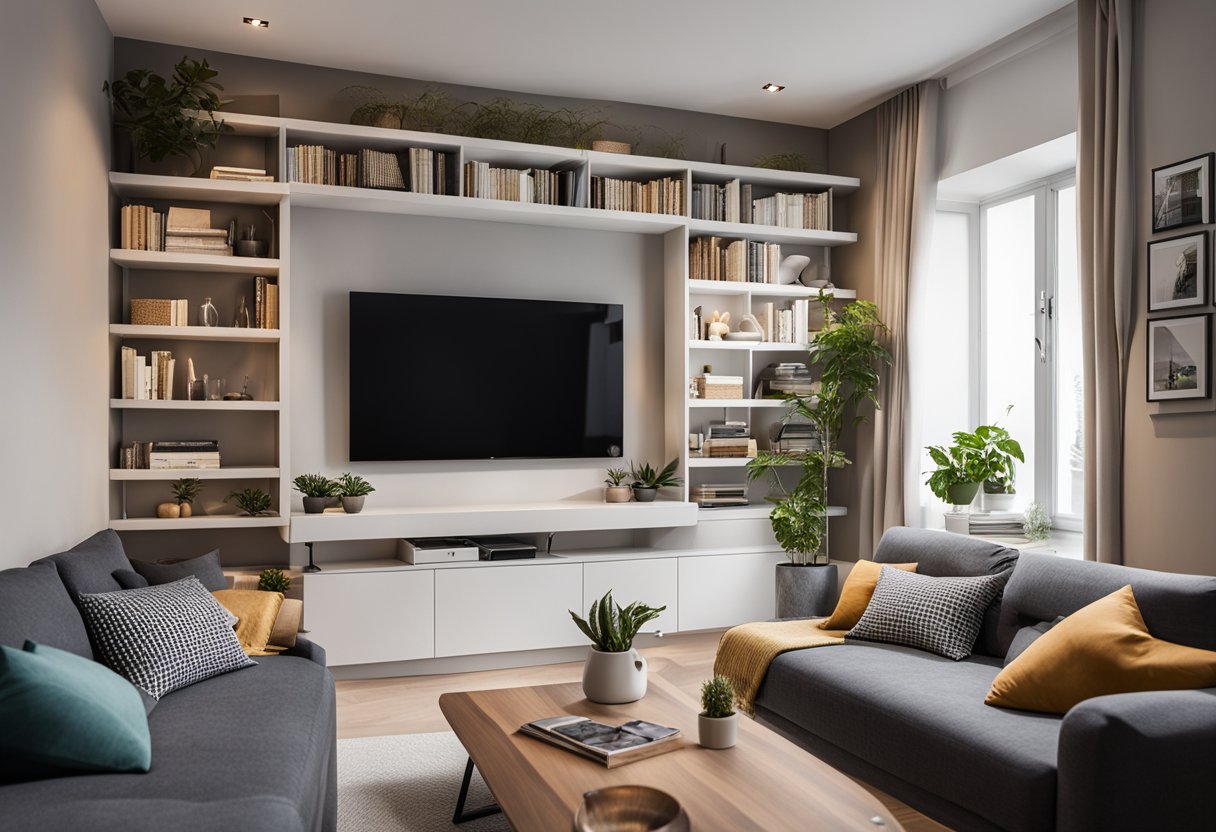
Are you struggling to make the most of a small space in your home? Don’t worry, we’ve got you covered with some professional insights from interior design founders and experts. Here are some tips to help you make the most of your limited space and create a stylish, functional living area.
Tips from Interior Design Founders
When it comes to designing small spaces, interior designers suggest that you should focus on creating an illusion of space. One way to do this is by incorporating a minimalist design principle. Minimalist design is all about creating a clean and uncluttered look. It helps to create an illusion of space by removing unnecessary items and decluttering the space.
Another tip from interior designers is to use a light colour scheme. Light colours can make a small space look bigger and brighter. You can also use a feature wall to add depth and dimension to your space. A feature wall is a great way to add a pop of colour or texture to your room without overwhelming the space.
Incorporating Minimalist Design Principles
When it comes to incorporating minimalist design principles, remember that less is more. Use furniture that is multi-functional, such as a sofa bed or storage ottoman. This will help to save space and reduce clutter. You can also use shelves and cabinets to store items that you don’t use every day.
Incorporating a minimalist design principle also means that you should focus on quality over quantity. Invest in high-quality furniture and decor that you love and that will last for years to come. This will help to create a timeless and stylish look that won’t go out of fashion.
By following these tips from interior design founders and incorporating minimalist design principles, you can create a stylish and functional living area in even the smallest of spaces.
Frequently Asked Questions
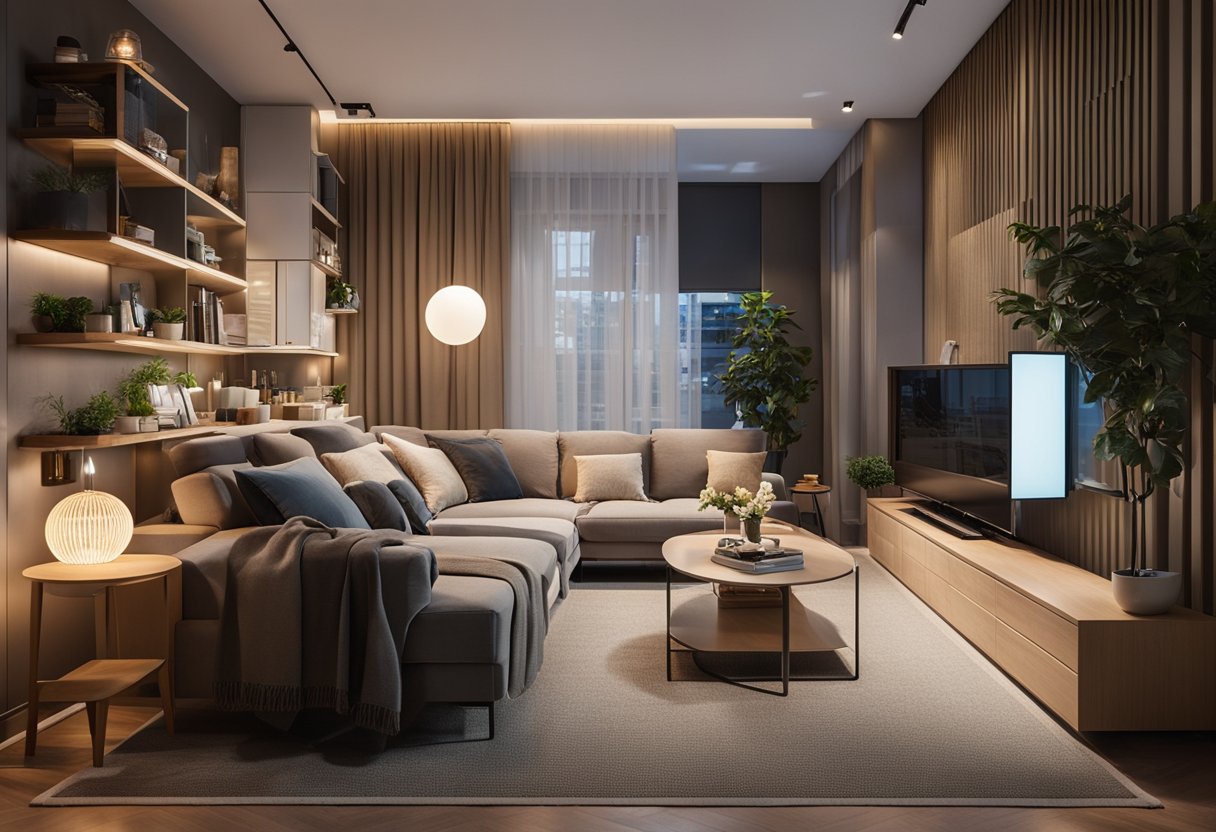
What are the top furniture solutions for a snug flat?
When it comes to furnishing a small space, it’s important to choose pieces that are both functional and stylish. Opt for multi-functional furniture, such as a sofa bed or storage ottoman, to maximize space. Consider investing in furniture that can be easily folded or stacked away when not in use, such as a drop-leaf dining table or a wall-mounted desk.
How can you give a compact room a more spacious feel through design?
There are several design tricks that can help make a small room feel more spacious. One of the most effective strategies is to use light colours on the walls and floors, which will reflect light and create a sense of openness. Mirrors can also be used to create the illusion of more space by reflecting light and giving the impression of depth. Additionally, using furniture with exposed legs can make a room feel more open and airy.
What are the cleverest ways to maximise space in a tiny abode?
Clever storage solutions are key when it comes to maximizing space in a small home. Consider investing in furniture with built-in storage, such as a bed with drawers underneath or a coffee table with hidden compartments. Utilize vertical space by installing shelves or hanging organizers on the walls. And don’t forget to make use of any underutilized spaces, such as under the stairs or in the corners of a room.
Could you share some thrifty interior design strategies for modest homes?
There are plenty of ways to decorate a small space without breaking the bank. One effective strategy is to use paint to create a focal point in the room, such as a brightly coloured accent wall. Another is to incorporate inexpensive textiles, such as throw pillows or curtains, to add texture and colour to the space. Finally, consider repurposing items you already own, such as turning an old ladder into a bookshelf or using mason jars as vases.
What are the best ways to decorate a two-bedroom flat with style and practicality?
When decorating a two-bedroom flat, it’s important to strike a balance between style and practicality. Consider investing in furniture that is both functional and aesthetically pleasing, such as a comfortable sofa and a stylish coffee table. Use colour and texture to add personality to the space, and don’t be afraid to mix and match patterns and materials. Finally, make sure to incorporate plenty of storage solutions to keep the space organized and clutter-free.
How do you infuse modern aesthetics into a small space without it feeling cramped?
To infuse modern aesthetics into a small space without it feeling cramped, it’s important to focus on simplicity and minimalism. Opt for furniture with clean lines and a streamlined design, and avoid cluttering the space with too many accessories or decorative items. Use a neutral colour palette with pops of bold colour to add interest to the space, and incorporate plenty of natural light to create a sense of openness and airiness.


